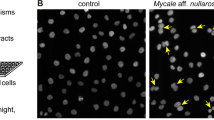Abstract
A methanol extract of Alsomitra macrocarpa leaves and branches induced a marked alteration of cell morphology in a human stellate cell line (LX-2). Similar morphologic alterations were observed in several other cell lines. Active compound was purified from the extract and determined to be cucurbitacin E (Cuc E). It has been known that Cuc E causes marked disruption of the actin cytoskeleton, supporting our observation, but how Cuc E altered the actin cytoskeleton has not been elucidated. By using the standard fluorescence assay using copolymerization and depolymerization of native and pyrene labelled actin, this study revealed that Cuc E interacted directly with actin consequently stabilizing the polymerized actin. When NIH-3T3 cells exogenously expressing YFP-labeled actin were treated with Cuc E, firstly the aggregation of globular actin and secondly the aggregation of actin including disrupted fibrous actin in the cells was observed.






Similar content being viewed by others
Abbreviations
- A. macrocarpa :
-
Alsomitra macrocarpa
- Cuc E:
-
Cucurbitacin E
- F-actin:
-
Fibrous actin
- G-actin:
-
Globular actin
References
Allingham JS, Klenchin VA, Rayment I (2006) Actin-targeting natural products: structures, properties and mechanisms of action. Cell Mol Life Sci 63:2119–2134
Attard E, Brincat MP, Cuschieri A (2005) Immunomodulatory activity of cucurbitacin E isolated from Ecballium elaterium. Fitoterapia 76:439–441
Bubb MR, Senderowicz AM, Sausville EA, Duncan KL, Korn ED (1994) Jasplakinolide, a cytotoxic natural product, induces actin polymerization and competitively inhibits the binding of phalloidin to F-actin. J Biol Chem 269:14869–14871
Bubb MR, Spector I, Beyer BB, Fosen KM (2000) Effects of jasplakinolide on the kinetics of actin polymerization. An explanation for certain in vivo observations. J Biol Chem 275:5163–5170
Chen JC, Chiu MH, Nie RL, Cordell GA, Qiu SX (2005) Cucurbitacins and cucurbitane glycosides: structures and biological activities. Nat Prod Rep 22:386–399
Duncan KL, Duncan MD, Alley MC, Sausville EA (1996) Cucurbitacin E-induced disruption of the actin and vimentin cytoskeleton in prostate carcinoma cells. Biochem Pharmacol 52:1553–1560
Hoehn H, Sprague CA, Martin GM (1973) Effects of cytochalasin B on cultivated human diploid fibroblasts and its use for the isolation of tetraploid clones. Exp Cell Res 76:170–174
Holzinger A, Meindl U (1997) Jasplakinolide, a novel actin targeting peptide, inhibits cell growth and induces actin filament polymerization in the green alga Micrasterias. Cell Motil Cytoskeleton 38:365–372
Kioka N, Sakata S, Kawauchi T et al. (1999) Vinexin: a novel vinculin-binding protein with multiple SH3 domains enhances actin cytoskeletal organization. J Cell Biol 144:59–69
Lavie D, Shvo Y, Gottlieb OR, Glotter E (1962) The Constituents of Ecbullium elaterium L. XV. The Structures of Elatericin A and Related Cucurbitacins. J Org Chem 27:4546–4557
Lavie D, Glotter E (1971) The cucurbitanes, a group of tetracyclic triterpenes. Fortschr Chem Org Naturst 29:307–362
Lee E, Shelden EA, Knecht DA (1998) Formation of F-actin aggregates in cells treated with actin stabilizing drugs. Cell Motil Cytoskeleton 39:122–133
Sheikh S, Gratzer WB, Pinder JC, Nash GB (1997) Actin polymerisation regulates integrin-mediated adhesion as well as rigidity of neutrophils. Biochem Biophys Res Commun 238:910–915
Usui T, Kazami S, Dohmae N, Mashimo Y, Kondo H, Tsuda M, Terasaki AG, Ohashi K, Kobayashi J, Osada H (2004) Amphidinolide h, a potent cytotoxic macrolide, covalently binds on actin subdomain 4 and stabilizes actin filament. Chem Biol 11:1269–1277
Vande V, Lavie D (1983) 13C NMR Spectroscopy of Cucurbitacins. Tetrahedron 39:317–321
Xu L, Hui AY, Albanis E, Arthur MJ, O'Byrne SM, Blaner WS, Mukherjee P, Friedman SL, Eng FJ (2005) Human hepatic stellate cell lines, LX-1 and LX-2: new tools for analysis of hepatic fibrosis. Gut 54:142–151
Yesilada E, Tanaka S, Sezik E, Tabata M (1988) Isolation of an anti-inflammatory principle from the juice of Ecballium elaterium. J Nat Prod 51:504–508
Acknowledgment
We gratefully acknowledge the kind provision of LX-2 and HSC-T6 cells by Dr. Scott L. Friedman, Division of Liver Diseases, Mount Sinai School of Medicine, New York, NY and USA.
Author information
Authors and Affiliations
Corresponding author
Rights and permissions
About this article
Cite this article
Momma, K., Masuzawa, Y., Nakai, N. et al. Direct interaction of Cucurbitacin E isolated from Alsomitra macrocarpa to actin filament. Cytotechnology 56, 33–39 (2008). https://doi.org/10.1007/s10616-007-9100-5
Received:
Accepted:
Published:
Issue Date:
DOI: https://doi.org/10.1007/s10616-007-9100-5




